Mental Health Nursing: A Case Study on Anxiety Disorder
VerifiedAdded on 2023/06/06
|13
|3552
|152
AI Summary
This paper analyzes the case study of a young student, Georgia, who is suffering from anxiety disorder and is at risk of developing chronic physical conditions due to her poor mental health. The paper discusses the understanding of mental health, personal recovery, mental health care needs, and suggestions for the practice of health professionals. The implications for the practice of health professionals are also discussed.
Contribute Materials
Your contribution can guide someone’s learning journey. Share your
documents today.
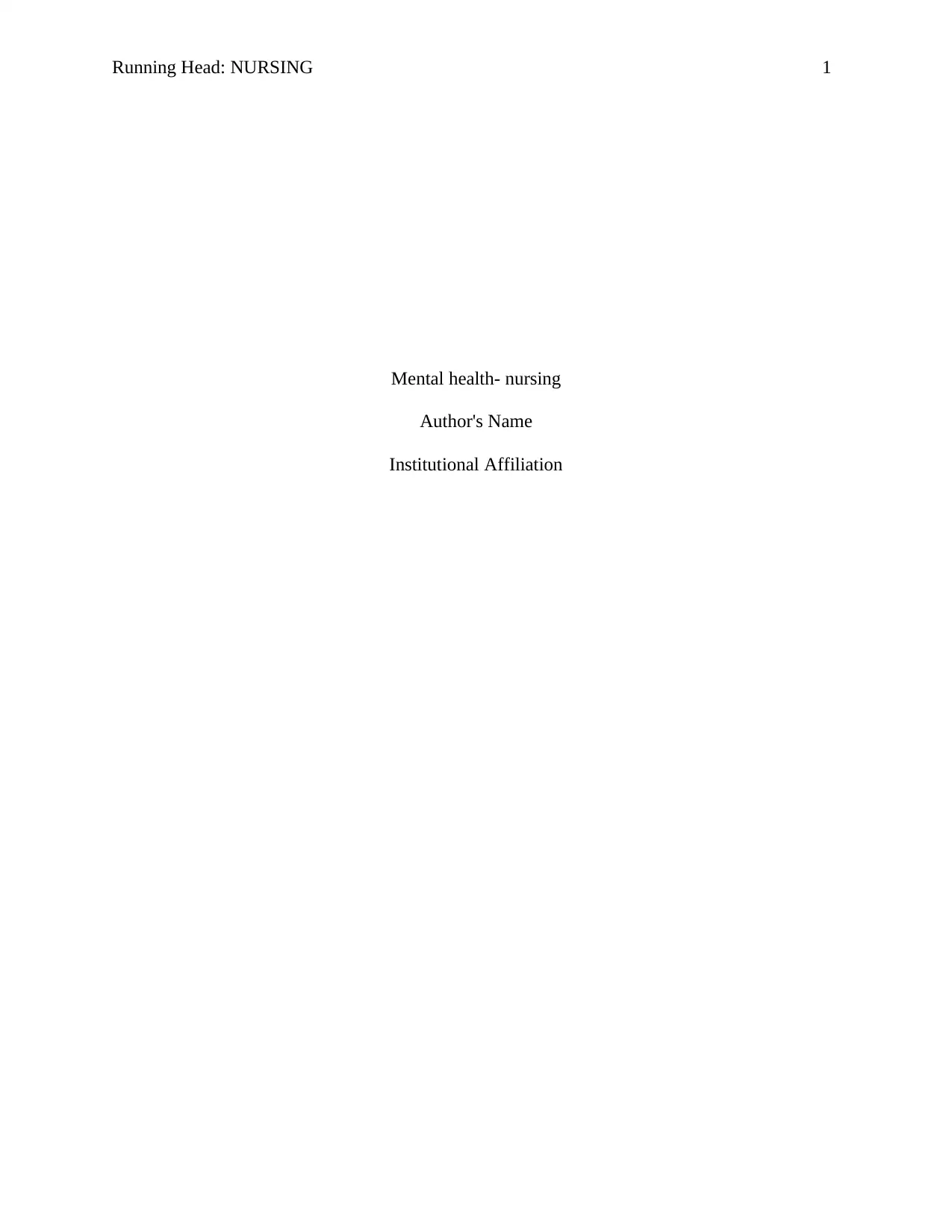
Running Head: NURSING 1
Mental health- nursing
Author's Name
Institutional Affiliation
Mental health- nursing
Author's Name
Institutional Affiliation
Secure Best Marks with AI Grader
Need help grading? Try our AI Grader for instant feedback on your assignments.
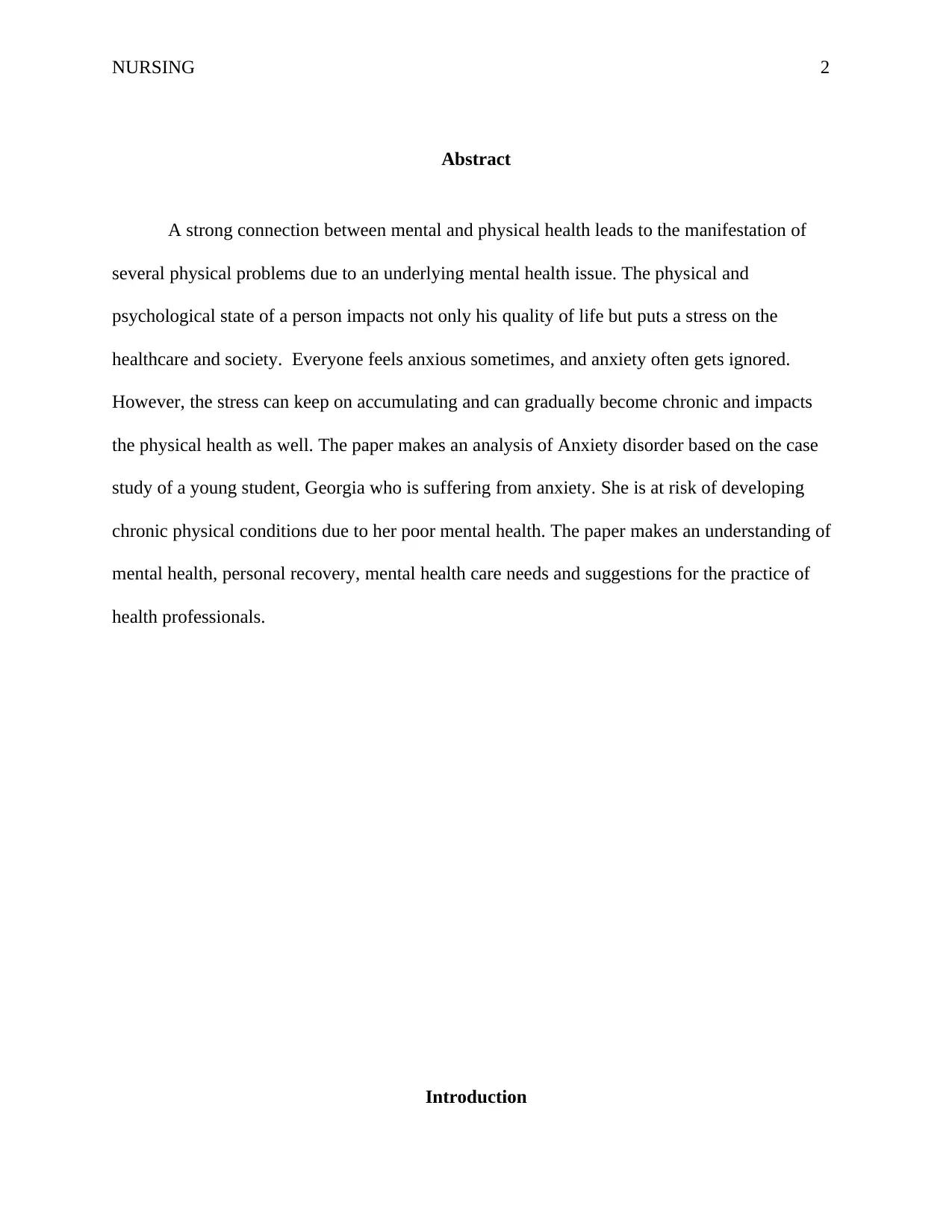
NURSING 2
Abstract
A strong connection between mental and physical health leads to the manifestation of
several physical problems due to an underlying mental health issue. The physical and
psychological state of a person impacts not only his quality of life but puts a stress on the
healthcare and society. Everyone feels anxious sometimes, and anxiety often gets ignored.
However, the stress can keep on accumulating and can gradually become chronic and impacts
the physical health as well. The paper makes an analysis of Anxiety disorder based on the case
study of a young student, Georgia who is suffering from anxiety. She is at risk of developing
chronic physical conditions due to her poor mental health. The paper makes an understanding of
mental health, personal recovery, mental health care needs and suggestions for the practice of
health professionals.
Introduction
Abstract
A strong connection between mental and physical health leads to the manifestation of
several physical problems due to an underlying mental health issue. The physical and
psychological state of a person impacts not only his quality of life but puts a stress on the
healthcare and society. Everyone feels anxious sometimes, and anxiety often gets ignored.
However, the stress can keep on accumulating and can gradually become chronic and impacts
the physical health as well. The paper makes an analysis of Anxiety disorder based on the case
study of a young student, Georgia who is suffering from anxiety. She is at risk of developing
chronic physical conditions due to her poor mental health. The paper makes an understanding of
mental health, personal recovery, mental health care needs and suggestions for the practice of
health professionals.
Introduction
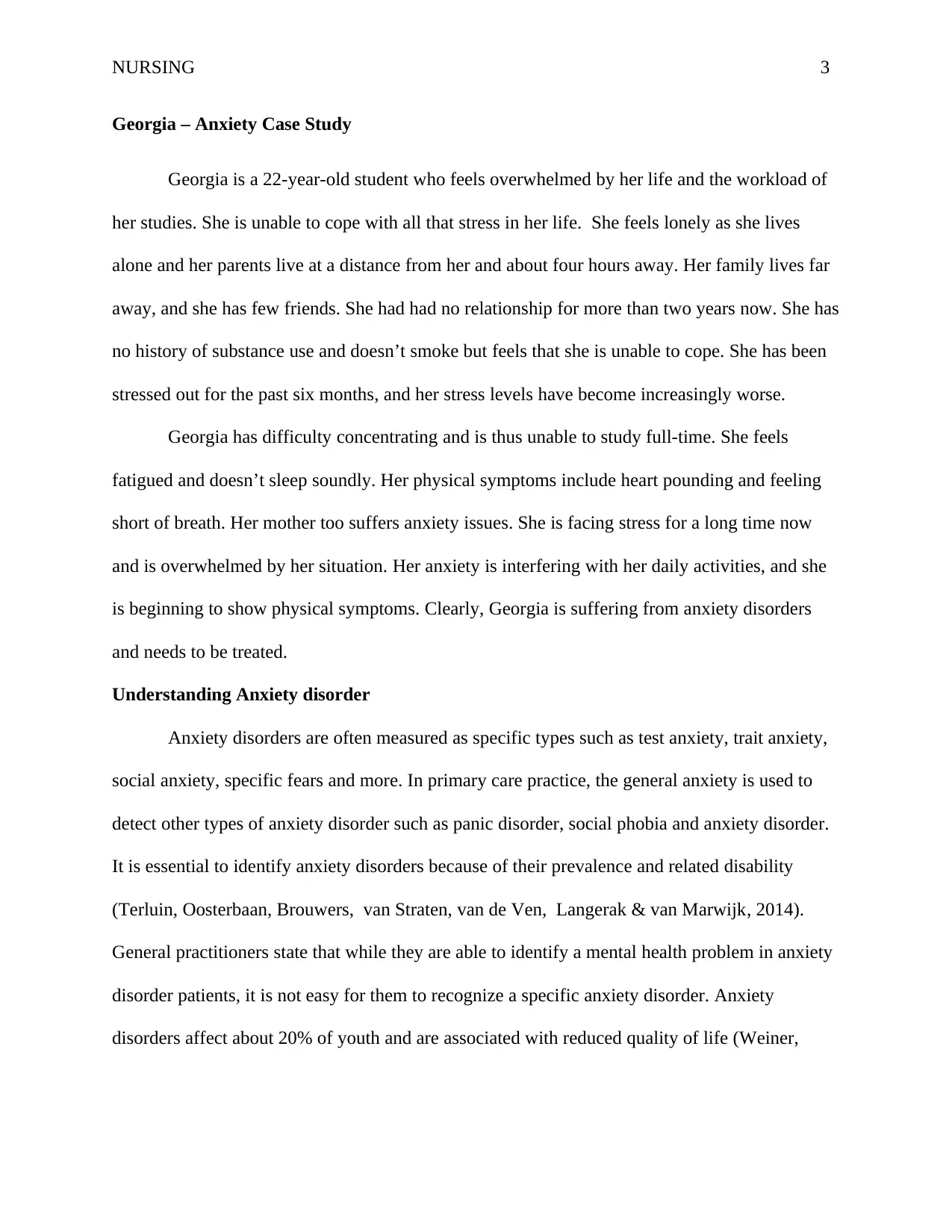
NURSING 3
Georgia – Anxiety Case Study
Georgia is a 22-year-old student who feels overwhelmed by her life and the workload of
her studies. She is unable to cope with all that stress in her life. She feels lonely as she lives
alone and her parents live at a distance from her and about four hours away. Her family lives far
away, and she has few friends. She had had no relationship for more than two years now. She has
no history of substance use and doesn’t smoke but feels that she is unable to cope. She has been
stressed out for the past six months, and her stress levels have become increasingly worse.
Georgia has difficulty concentrating and is thus unable to study full-time. She feels
fatigued and doesn’t sleep soundly. Her physical symptoms include heart pounding and feeling
short of breath. Her mother too suffers anxiety issues. She is facing stress for a long time now
and is overwhelmed by her situation. Her anxiety is interfering with her daily activities, and she
is beginning to show physical symptoms. Clearly, Georgia is suffering from anxiety disorders
and needs to be treated.
Understanding Anxiety disorder
Anxiety disorders are often measured as specific types such as test anxiety, trait anxiety,
social anxiety, specific fears and more. In primary care practice, the general anxiety is used to
detect other types of anxiety disorder such as panic disorder, social phobia and anxiety disorder.
It is essential to identify anxiety disorders because of their prevalence and related disability
(Terluin, Oosterbaan, Brouwers, van Straten, van de Ven, Langerak & van Marwijk, 2014).
General practitioners state that while they are able to identify a mental health problem in anxiety
disorder patients, it is not easy for them to recognize a specific anxiety disorder. Anxiety
disorders affect about 20% of youth and are associated with reduced quality of life (Weiner,
Georgia – Anxiety Case Study
Georgia is a 22-year-old student who feels overwhelmed by her life and the workload of
her studies. She is unable to cope with all that stress in her life. She feels lonely as she lives
alone and her parents live at a distance from her and about four hours away. Her family lives far
away, and she has few friends. She had had no relationship for more than two years now. She has
no history of substance use and doesn’t smoke but feels that she is unable to cope. She has been
stressed out for the past six months, and her stress levels have become increasingly worse.
Georgia has difficulty concentrating and is thus unable to study full-time. She feels
fatigued and doesn’t sleep soundly. Her physical symptoms include heart pounding and feeling
short of breath. Her mother too suffers anxiety issues. She is facing stress for a long time now
and is overwhelmed by her situation. Her anxiety is interfering with her daily activities, and she
is beginning to show physical symptoms. Clearly, Georgia is suffering from anxiety disorders
and needs to be treated.
Understanding Anxiety disorder
Anxiety disorders are often measured as specific types such as test anxiety, trait anxiety,
social anxiety, specific fears and more. In primary care practice, the general anxiety is used to
detect other types of anxiety disorder such as panic disorder, social phobia and anxiety disorder.
It is essential to identify anxiety disorders because of their prevalence and related disability
(Terluin, Oosterbaan, Brouwers, van Straten, van de Ven, Langerak & van Marwijk, 2014).
General practitioners state that while they are able to identify a mental health problem in anxiety
disorder patients, it is not easy for them to recognize a specific anxiety disorder. Anxiety
disorders affect about 20% of youth and are associated with reduced quality of life (Weiner,
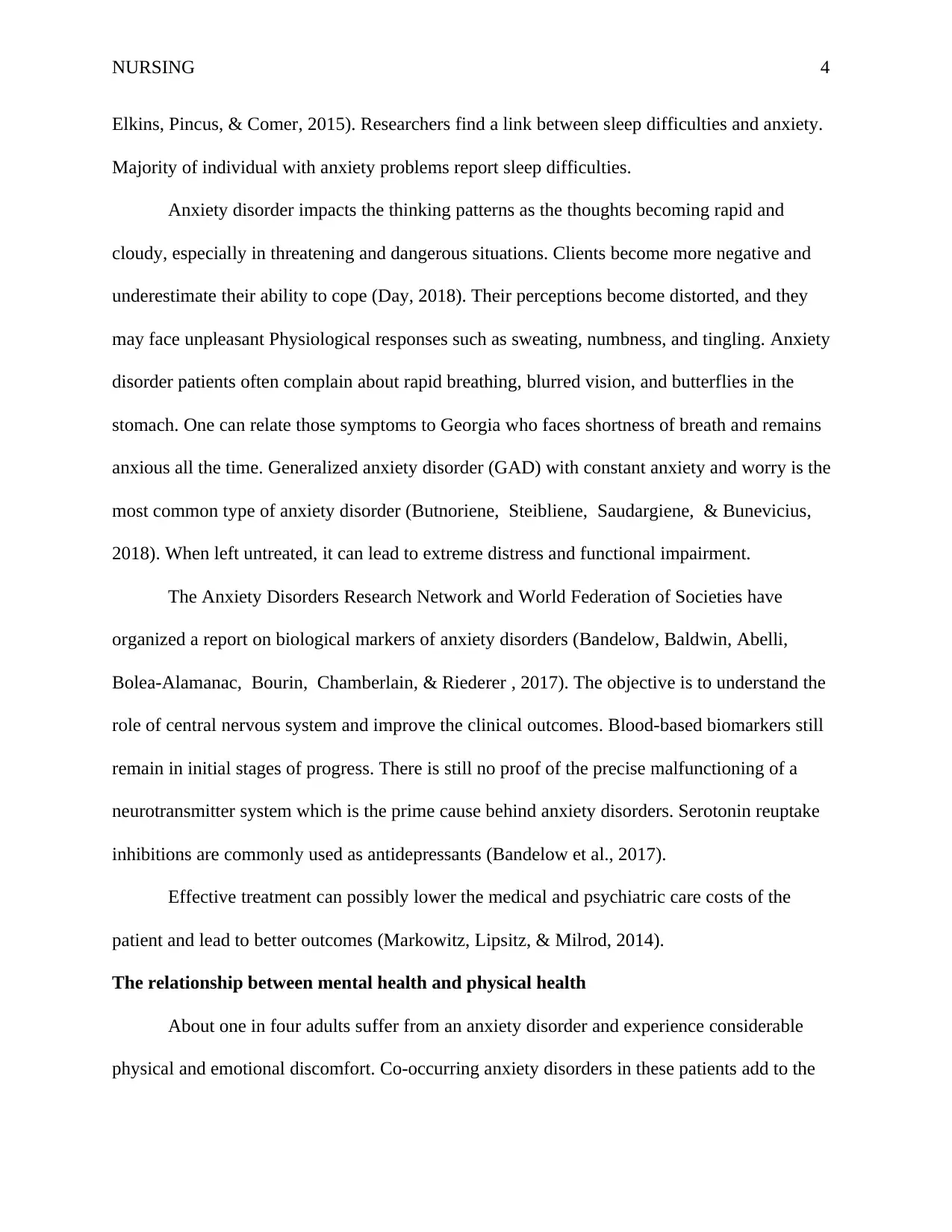
NURSING 4
Elkins, Pincus, & Comer, 2015). Researchers find a link between sleep difficulties and anxiety.
Majority of individual with anxiety problems report sleep difficulties.
Anxiety disorder impacts the thinking patterns as the thoughts becoming rapid and
cloudy, especially in threatening and dangerous situations. Clients become more negative and
underestimate their ability to cope (Day, 2018). Their perceptions become distorted, and they
may face unpleasant Physiological responses such as sweating, numbness, and tingling. Anxiety
disorder patients often complain about rapid breathing, blurred vision, and butterflies in the
stomach. One can relate those symptoms to Georgia who faces shortness of breath and remains
anxious all the time. Generalized anxiety disorder (GAD) with constant anxiety and worry is the
most common type of anxiety disorder (Butnoriene, Steibliene, Saudargiene, & Bunevicius,
2018). When left untreated, it can lead to extreme distress and functional impairment.
The Anxiety Disorders Research Network and World Federation of Societies have
organized a report on biological markers of anxiety disorders (Bandelow, Baldwin, Abelli,
Bolea-Alamanac, Bourin, Chamberlain, & Riederer , 2017). The objective is to understand the
role of central nervous system and improve the clinical outcomes. Blood-based biomarkers still
remain in initial stages of progress. There is still no proof of the precise malfunctioning of a
neurotransmitter system which is the prime cause behind anxiety disorders. Serotonin reuptake
inhibitions are commonly used as antidepressants (Bandelow et al., 2017).
Effective treatment can possibly lower the medical and psychiatric care costs of the
patient and lead to better outcomes (Markowitz, Lipsitz, & Milrod, 2014).
The relationship between mental health and physical health
About one in four adults suffer from an anxiety disorder and experience considerable
physical and emotional discomfort. Co-occurring anxiety disorders in these patients add to the
Elkins, Pincus, & Comer, 2015). Researchers find a link between sleep difficulties and anxiety.
Majority of individual with anxiety problems report sleep difficulties.
Anxiety disorder impacts the thinking patterns as the thoughts becoming rapid and
cloudy, especially in threatening and dangerous situations. Clients become more negative and
underestimate their ability to cope (Day, 2018). Their perceptions become distorted, and they
may face unpleasant Physiological responses such as sweating, numbness, and tingling. Anxiety
disorder patients often complain about rapid breathing, blurred vision, and butterflies in the
stomach. One can relate those symptoms to Georgia who faces shortness of breath and remains
anxious all the time. Generalized anxiety disorder (GAD) with constant anxiety and worry is the
most common type of anxiety disorder (Butnoriene, Steibliene, Saudargiene, & Bunevicius,
2018). When left untreated, it can lead to extreme distress and functional impairment.
The Anxiety Disorders Research Network and World Federation of Societies have
organized a report on biological markers of anxiety disorders (Bandelow, Baldwin, Abelli,
Bolea-Alamanac, Bourin, Chamberlain, & Riederer , 2017). The objective is to understand the
role of central nervous system and improve the clinical outcomes. Blood-based biomarkers still
remain in initial stages of progress. There is still no proof of the precise malfunctioning of a
neurotransmitter system which is the prime cause behind anxiety disorders. Serotonin reuptake
inhibitions are commonly used as antidepressants (Bandelow et al., 2017).
Effective treatment can possibly lower the medical and psychiatric care costs of the
patient and lead to better outcomes (Markowitz, Lipsitz, & Milrod, 2014).
The relationship between mental health and physical health
About one in four adults suffer from an anxiety disorder and experience considerable
physical and emotional discomfort. Co-occurring anxiety disorders in these patients add to the
Secure Best Marks with AI Grader
Need help grading? Try our AI Grader for instant feedback on your assignments.
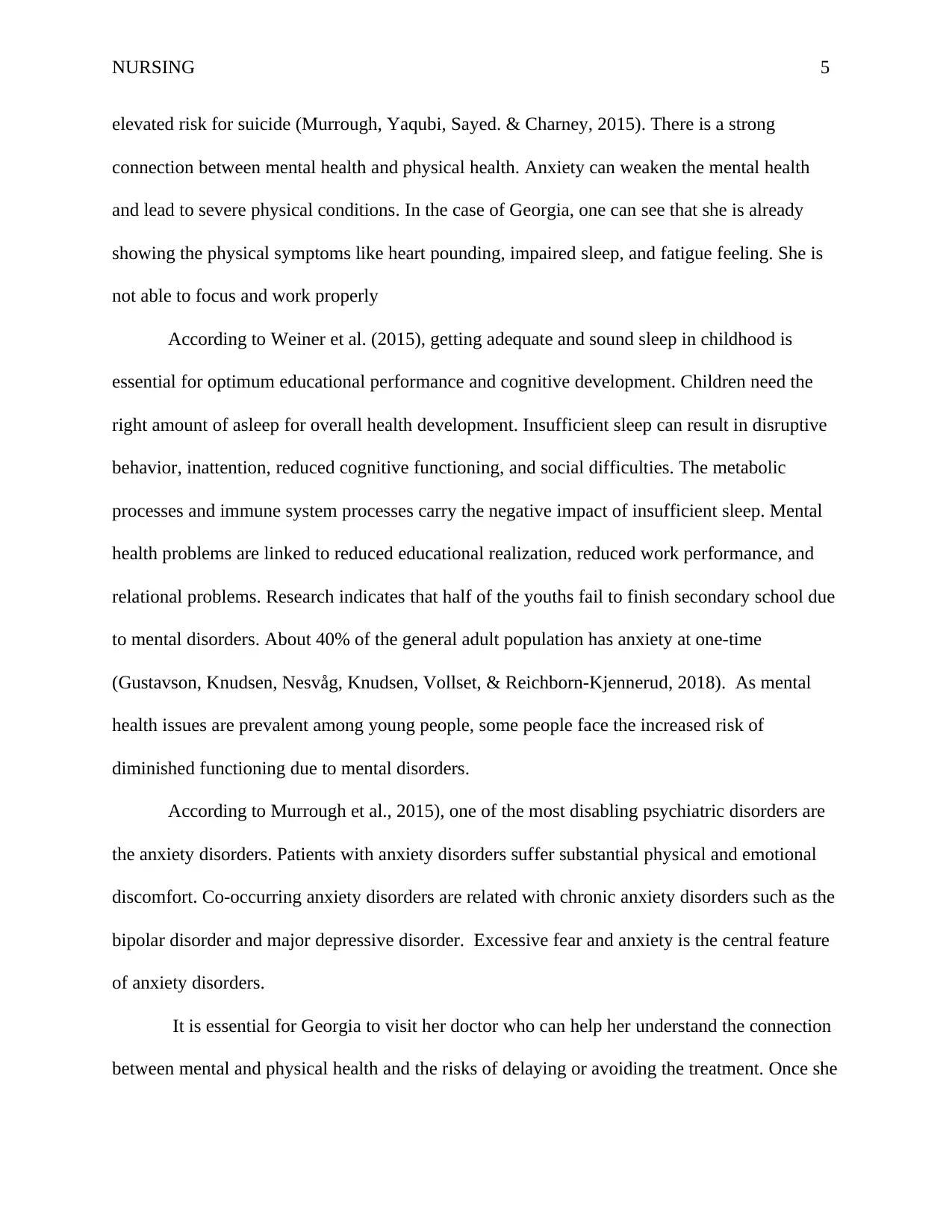
NURSING 5
elevated risk for suicide (Murrough, Yaqubi, Sayed. & Charney, 2015). There is a strong
connection between mental health and physical health. Anxiety can weaken the mental health
and lead to severe physical conditions. In the case of Georgia, one can see that she is already
showing the physical symptoms like heart pounding, impaired sleep, and fatigue feeling. She is
not able to focus and work properly
According to Weiner et al. (2015), getting adequate and sound sleep in childhood is
essential for optimum educational performance and cognitive development. Children need the
right amount of asleep for overall health development. Insufficient sleep can result in disruptive
behavior, inattention, reduced cognitive functioning, and social difficulties. The metabolic
processes and immune system processes carry the negative impact of insufficient sleep. Mental
health problems are linked to reduced educational realization, reduced work performance, and
relational problems. Research indicates that half of the youths fail to finish secondary school due
to mental disorders. About 40% of the general adult population has anxiety at one-time
(Gustavson, Knudsen, Nesvåg, Knudsen, Vollset, & Reichborn-Kjennerud, 2018). As mental
health issues are prevalent among young people, some people face the increased risk of
diminished functioning due to mental disorders.
According to Murrough et al., 2015), one of the most disabling psychiatric disorders are
the anxiety disorders. Patients with anxiety disorders suffer substantial physical and emotional
discomfort. Co-occurring anxiety disorders are related with chronic anxiety disorders such as the
bipolar disorder and major depressive disorder. Excessive fear and anxiety is the central feature
of anxiety disorders.
It is essential for Georgia to visit her doctor who can help her understand the connection
between mental and physical health and the risks of delaying or avoiding the treatment. Once she
elevated risk for suicide (Murrough, Yaqubi, Sayed. & Charney, 2015). There is a strong
connection between mental health and physical health. Anxiety can weaken the mental health
and lead to severe physical conditions. In the case of Georgia, one can see that she is already
showing the physical symptoms like heart pounding, impaired sleep, and fatigue feeling. She is
not able to focus and work properly
According to Weiner et al. (2015), getting adequate and sound sleep in childhood is
essential for optimum educational performance and cognitive development. Children need the
right amount of asleep for overall health development. Insufficient sleep can result in disruptive
behavior, inattention, reduced cognitive functioning, and social difficulties. The metabolic
processes and immune system processes carry the negative impact of insufficient sleep. Mental
health problems are linked to reduced educational realization, reduced work performance, and
relational problems. Research indicates that half of the youths fail to finish secondary school due
to mental disorders. About 40% of the general adult population has anxiety at one-time
(Gustavson, Knudsen, Nesvåg, Knudsen, Vollset, & Reichborn-Kjennerud, 2018). As mental
health issues are prevalent among young people, some people face the increased risk of
diminished functioning due to mental disorders.
According to Murrough et al., 2015), one of the most disabling psychiatric disorders are
the anxiety disorders. Patients with anxiety disorders suffer substantial physical and emotional
discomfort. Co-occurring anxiety disorders are related with chronic anxiety disorders such as the
bipolar disorder and major depressive disorder. Excessive fear and anxiety is the central feature
of anxiety disorders.
It is essential for Georgia to visit her doctor who can help her understand the connection
between mental and physical health and the risks of delaying or avoiding the treatment. Once she
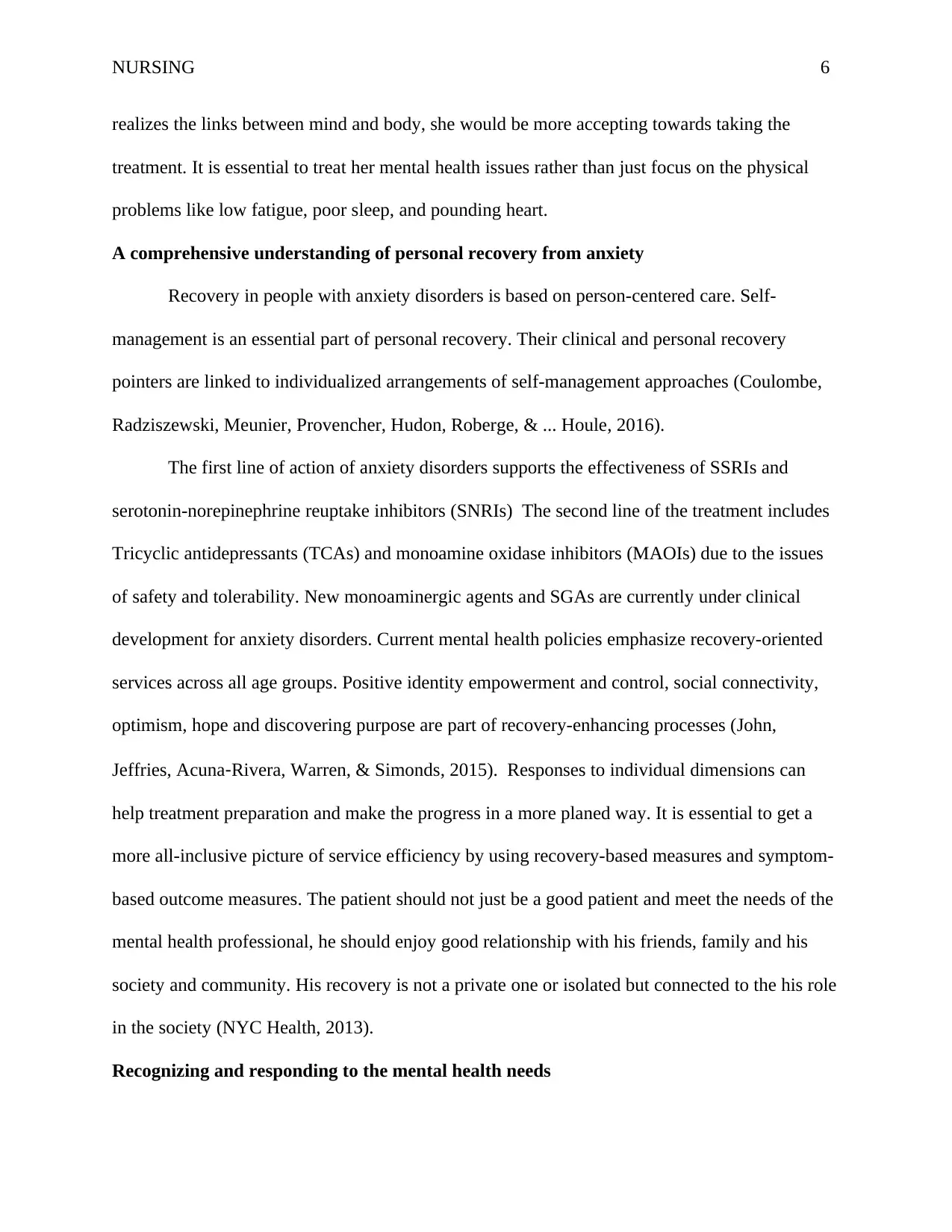
NURSING 6
realizes the links between mind and body, she would be more accepting towards taking the
treatment. It is essential to treat her mental health issues rather than just focus on the physical
problems like low fatigue, poor sleep, and pounding heart.
A comprehensive understanding of personal recovery from anxiety
Recovery in people with anxiety disorders is based on person-centered care. Self-
management is an essential part of personal recovery. Their clinical and personal recovery
pointers are linked to individualized arrangements of self-management approaches (Coulombe,
Radziszewski, Meunier, Provencher, Hudon, Roberge, & ... Houle, 2016).
The first line of action of anxiety disorders supports the effectiveness of SSRIs and
serotonin-norepinephrine reuptake inhibitors (SNRIs) The second line of the treatment includes
Tricyclic antidepressants (TCAs) and monoamine oxidase inhibitors (MAOIs) due to the issues
of safety and tolerability. New monoaminergic agents and SGAs are currently under clinical
development for anxiety disorders. Current mental health policies emphasize recovery-oriented
services across all age groups. Positive identity empowerment and control, social connectivity,
optimism, hope and discovering purpose are part of recovery-enhancing processes (John,
Jeffries, Acuna‐Rivera, Warren, & Simonds, 2015). Responses to individual dimensions can
help treatment preparation and make the progress in a more planed way. It is essential to get a
more all-inclusive picture of service efficiency by using recovery-based measures and symptom-
based outcome measures. The patient should not just be a good patient and meet the needs of the
mental health professional, he should enjoy good relationship with his friends, family and his
society and community. His recovery is not a private one or isolated but connected to the his role
in the society (NYC Health, 2013).
Recognizing and responding to the mental health needs
realizes the links between mind and body, she would be more accepting towards taking the
treatment. It is essential to treat her mental health issues rather than just focus on the physical
problems like low fatigue, poor sleep, and pounding heart.
A comprehensive understanding of personal recovery from anxiety
Recovery in people with anxiety disorders is based on person-centered care. Self-
management is an essential part of personal recovery. Their clinical and personal recovery
pointers are linked to individualized arrangements of self-management approaches (Coulombe,
Radziszewski, Meunier, Provencher, Hudon, Roberge, & ... Houle, 2016).
The first line of action of anxiety disorders supports the effectiveness of SSRIs and
serotonin-norepinephrine reuptake inhibitors (SNRIs) The second line of the treatment includes
Tricyclic antidepressants (TCAs) and monoamine oxidase inhibitors (MAOIs) due to the issues
of safety and tolerability. New monoaminergic agents and SGAs are currently under clinical
development for anxiety disorders. Current mental health policies emphasize recovery-oriented
services across all age groups. Positive identity empowerment and control, social connectivity,
optimism, hope and discovering purpose are part of recovery-enhancing processes (John,
Jeffries, Acuna‐Rivera, Warren, & Simonds, 2015). Responses to individual dimensions can
help treatment preparation and make the progress in a more planed way. It is essential to get a
more all-inclusive picture of service efficiency by using recovery-based measures and symptom-
based outcome measures. The patient should not just be a good patient and meet the needs of the
mental health professional, he should enjoy good relationship with his friends, family and his
society and community. His recovery is not a private one or isolated but connected to the his role
in the society (NYC Health, 2013).
Recognizing and responding to the mental health needs
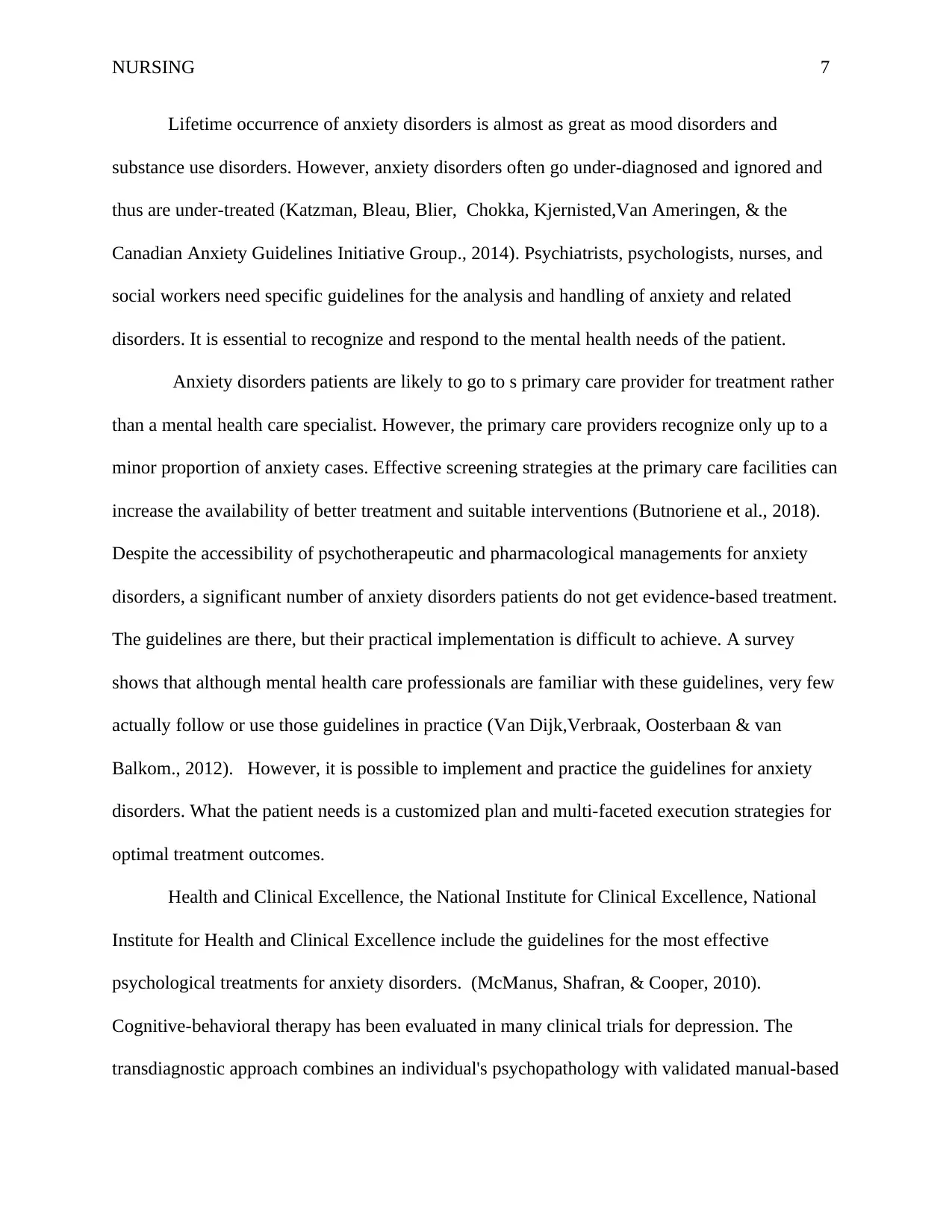
NURSING 7
Lifetime occurrence of anxiety disorders is almost as great as mood disorders and
substance use disorders. However, anxiety disorders often go under-diagnosed and ignored and
thus are under-treated (Katzman, Bleau, Blier, Chokka, Kjernisted,Van Ameringen, & the
Canadian Anxiety Guidelines Initiative Group., 2014). Psychiatrists, psychologists, nurses, and
social workers need specific guidelines for the analysis and handling of anxiety and related
disorders. It is essential to recognize and respond to the mental health needs of the patient.
Anxiety disorders patients are likely to go to s primary care provider for treatment rather
than a mental health care specialist. However, the primary care providers recognize only up to a
minor proportion of anxiety cases. Effective screening strategies at the primary care facilities can
increase the availability of better treatment and suitable interventions (Butnoriene et al., 2018).
Despite the accessibility of psychotherapeutic and pharmacological managements for anxiety
disorders, a significant number of anxiety disorders patients do not get evidence-based treatment.
The guidelines are there, but their practical implementation is difficult to achieve. A survey
shows that although mental health care professionals are familiar with these guidelines, very few
actually follow or use those guidelines in practice (Van Dijk,Verbraak, Oosterbaan & van
Balkom., 2012). However, it is possible to implement and practice the guidelines for anxiety
disorders. What the patient needs is a customized plan and multi-faceted execution strategies for
optimal treatment outcomes.
Health and Clinical Excellence, the National Institute for Clinical Excellence, National
Institute for Health and Clinical Excellence include the guidelines for the most effective
psychological treatments for anxiety disorders. (McManus, Shafran, & Cooper, 2010).
Cognitive-behavioral therapy has been evaluated in many clinical trials for depression. The
transdiagnostic approach combines an individual's psychopathology with validated manual-based
Lifetime occurrence of anxiety disorders is almost as great as mood disorders and
substance use disorders. However, anxiety disorders often go under-diagnosed and ignored and
thus are under-treated (Katzman, Bleau, Blier, Chokka, Kjernisted,Van Ameringen, & the
Canadian Anxiety Guidelines Initiative Group., 2014). Psychiatrists, psychologists, nurses, and
social workers need specific guidelines for the analysis and handling of anxiety and related
disorders. It is essential to recognize and respond to the mental health needs of the patient.
Anxiety disorders patients are likely to go to s primary care provider for treatment rather
than a mental health care specialist. However, the primary care providers recognize only up to a
minor proportion of anxiety cases. Effective screening strategies at the primary care facilities can
increase the availability of better treatment and suitable interventions (Butnoriene et al., 2018).
Despite the accessibility of psychotherapeutic and pharmacological managements for anxiety
disorders, a significant number of anxiety disorders patients do not get evidence-based treatment.
The guidelines are there, but their practical implementation is difficult to achieve. A survey
shows that although mental health care professionals are familiar with these guidelines, very few
actually follow or use those guidelines in practice (Van Dijk,Verbraak, Oosterbaan & van
Balkom., 2012). However, it is possible to implement and practice the guidelines for anxiety
disorders. What the patient needs is a customized plan and multi-faceted execution strategies for
optimal treatment outcomes.
Health and Clinical Excellence, the National Institute for Clinical Excellence, National
Institute for Health and Clinical Excellence include the guidelines for the most effective
psychological treatments for anxiety disorders. (McManus, Shafran, & Cooper, 2010).
Cognitive-behavioral therapy has been evaluated in many clinical trials for depression. The
transdiagnostic approach combines an individual's psychopathology with validated manual-based
Paraphrase This Document
Need a fresh take? Get an instant paraphrase of this document with our AI Paraphraser
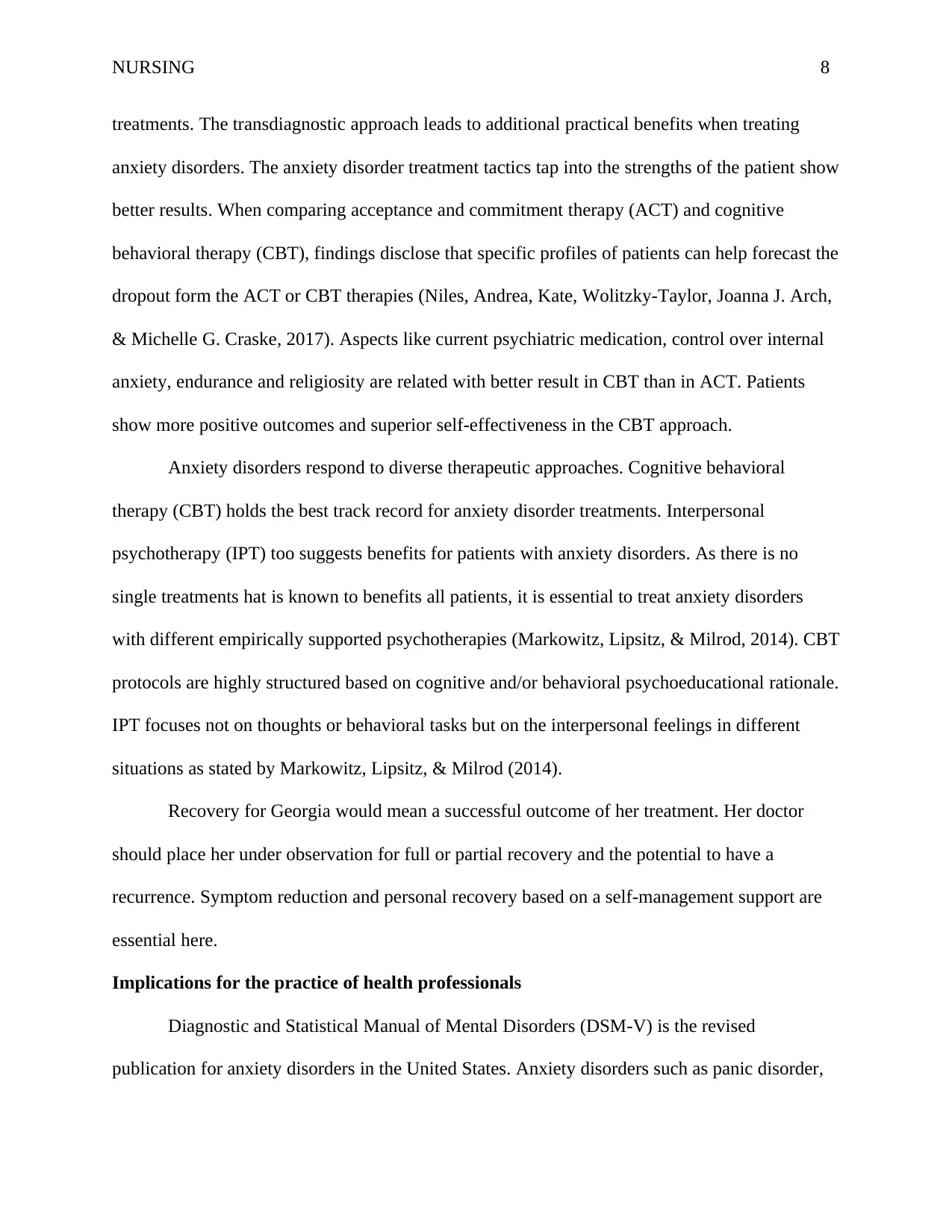
NURSING 8
treatments. The transdiagnostic approach leads to additional practical benefits when treating
anxiety disorders. The anxiety disorder treatment tactics tap into the strengths of the patient show
better results. When comparing acceptance and commitment therapy (ACT) and cognitive
behavioral therapy (CBT), findings disclose that specific profiles of patients can help forecast the
dropout form the ACT or CBT therapies (Niles, Andrea, Kate, Wolitzky-Taylor, Joanna J. Arch,
& Michelle G. Craske, 2017). Aspects like current psychiatric medication, control over internal
anxiety, endurance and religiosity are related with better result in CBT than in ACT. Patients
show more positive outcomes and superior self-effectiveness in the CBT approach.
Anxiety disorders respond to diverse therapeutic approaches. Cognitive behavioral
therapy (CBT) holds the best track record for anxiety disorder treatments. Interpersonal
psychotherapy (IPT) too suggests benefits for patients with anxiety disorders. As there is no
single treatments hat is known to benefits all patients, it is essential to treat anxiety disorders
with different empirically supported psychotherapies (Markowitz, Lipsitz, & Milrod, 2014). CBT
protocols are highly structured based on cognitive and/or behavioral psychoeducational rationale.
IPT focuses not on thoughts or behavioral tasks but on the interpersonal feelings in different
situations as stated by Markowitz, Lipsitz, & Milrod (2014).
Recovery for Georgia would mean a successful outcome of her treatment. Her doctor
should place her under observation for full or partial recovery and the potential to have a
recurrence. Symptom reduction and personal recovery based on a self-management support are
essential here.
Implications for the practice of health professionals
Diagnostic and Statistical Manual of Mental Disorders (DSM-V) is the revised
publication for anxiety disorders in the United States. Anxiety disorders such as panic disorder,
treatments. The transdiagnostic approach leads to additional practical benefits when treating
anxiety disorders. The anxiety disorder treatment tactics tap into the strengths of the patient show
better results. When comparing acceptance and commitment therapy (ACT) and cognitive
behavioral therapy (CBT), findings disclose that specific profiles of patients can help forecast the
dropout form the ACT or CBT therapies (Niles, Andrea, Kate, Wolitzky-Taylor, Joanna J. Arch,
& Michelle G. Craske, 2017). Aspects like current psychiatric medication, control over internal
anxiety, endurance and religiosity are related with better result in CBT than in ACT. Patients
show more positive outcomes and superior self-effectiveness in the CBT approach.
Anxiety disorders respond to diverse therapeutic approaches. Cognitive behavioral
therapy (CBT) holds the best track record for anxiety disorder treatments. Interpersonal
psychotherapy (IPT) too suggests benefits for patients with anxiety disorders. As there is no
single treatments hat is known to benefits all patients, it is essential to treat anxiety disorders
with different empirically supported psychotherapies (Markowitz, Lipsitz, & Milrod, 2014). CBT
protocols are highly structured based on cognitive and/or behavioral psychoeducational rationale.
IPT focuses not on thoughts or behavioral tasks but on the interpersonal feelings in different
situations as stated by Markowitz, Lipsitz, & Milrod (2014).
Recovery for Georgia would mean a successful outcome of her treatment. Her doctor
should place her under observation for full or partial recovery and the potential to have a
recurrence. Symptom reduction and personal recovery based on a self-management support are
essential here.
Implications for the practice of health professionals
Diagnostic and Statistical Manual of Mental Disorders (DSM-V) is the revised
publication for anxiety disorders in the United States. Anxiety disorders such as panic disorder,
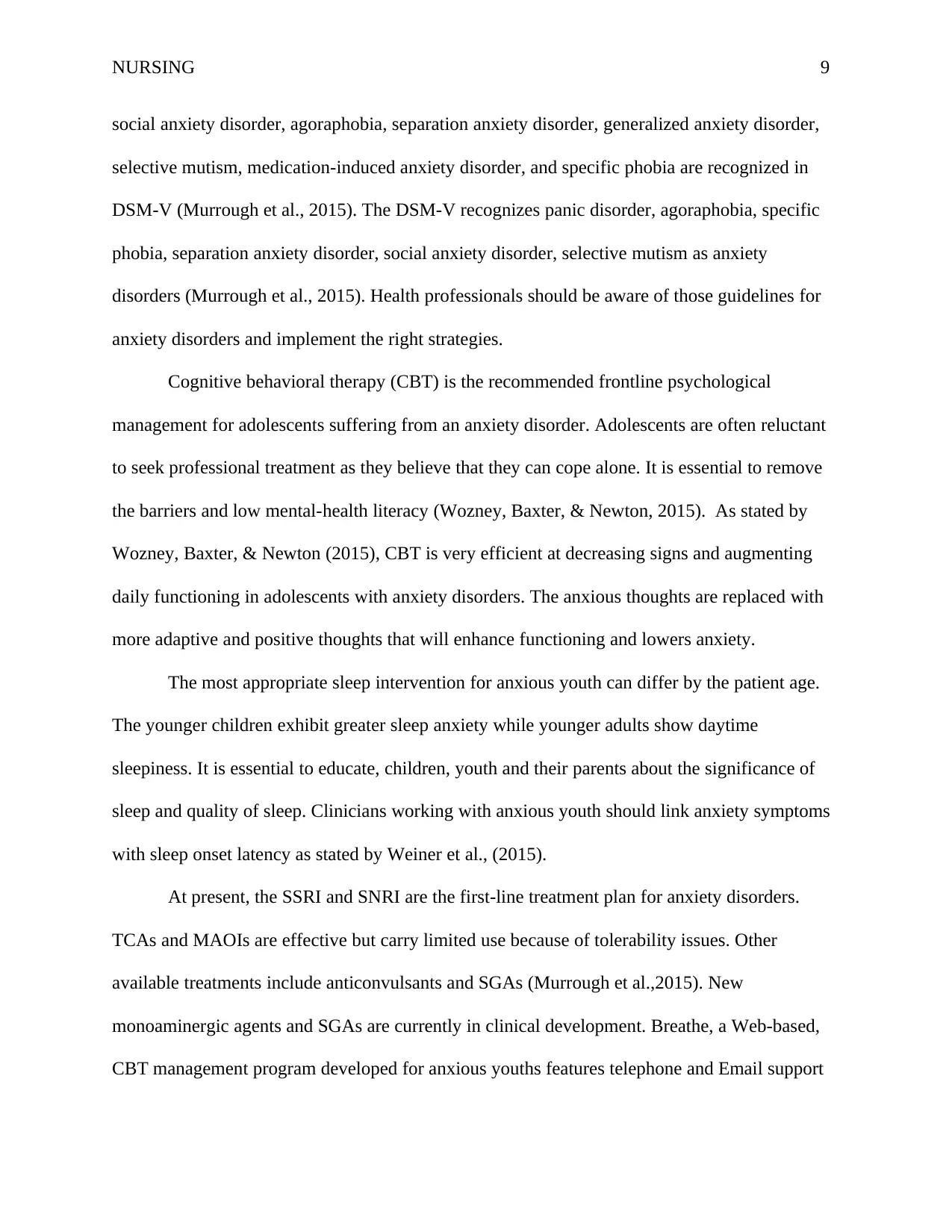
NURSING 9
social anxiety disorder, agoraphobia, separation anxiety disorder, generalized anxiety disorder,
selective mutism, medication-induced anxiety disorder, and specific phobia are recognized in
DSM-V (Murrough et al., 2015). The DSM-V recognizes panic disorder, agoraphobia, specific
phobia, separation anxiety disorder, social anxiety disorder, selective mutism as anxiety
disorders (Murrough et al., 2015). Health professionals should be aware of those guidelines for
anxiety disorders and implement the right strategies.
Cognitive behavioral therapy (CBT) is the recommended frontline psychological
management for adolescents suffering from an anxiety disorder. Adolescents are often reluctant
to seek professional treatment as they believe that they can cope alone. It is essential to remove
the barriers and low mental-health literacy (Wozney, Baxter, & Newton, 2015). As stated by
Wozney, Baxter, & Newton (2015), CBT is very efficient at decreasing signs and augmenting
daily functioning in adolescents with anxiety disorders. The anxious thoughts are replaced with
more adaptive and positive thoughts that will enhance functioning and lowers anxiety.
The most appropriate sleep intervention for anxious youth can differ by the patient age.
The younger children exhibit greater sleep anxiety while younger adults show daytime
sleepiness. It is essential to educate, children, youth and their parents about the significance of
sleep and quality of sleep. Clinicians working with anxious youth should link anxiety symptoms
with sleep onset latency as stated by Weiner et al., (2015).
At present, the SSRI and SNRI are the first-line treatment plan for anxiety disorders.
TCAs and MAOIs are effective but carry limited use because of tolerability issues. Other
available treatments include anticonvulsants and SGAs (Murrough et al.,2015). New
monoaminergic agents and SGAs are currently in clinical development. Breathe, a Web-based,
CBT management program developed for anxious youths features telephone and Email support
social anxiety disorder, agoraphobia, separation anxiety disorder, generalized anxiety disorder,
selective mutism, medication-induced anxiety disorder, and specific phobia are recognized in
DSM-V (Murrough et al., 2015). The DSM-V recognizes panic disorder, agoraphobia, specific
phobia, separation anxiety disorder, social anxiety disorder, selective mutism as anxiety
disorders (Murrough et al., 2015). Health professionals should be aware of those guidelines for
anxiety disorders and implement the right strategies.
Cognitive behavioral therapy (CBT) is the recommended frontline psychological
management for adolescents suffering from an anxiety disorder. Adolescents are often reluctant
to seek professional treatment as they believe that they can cope alone. It is essential to remove
the barriers and low mental-health literacy (Wozney, Baxter, & Newton, 2015). As stated by
Wozney, Baxter, & Newton (2015), CBT is very efficient at decreasing signs and augmenting
daily functioning in adolescents with anxiety disorders. The anxious thoughts are replaced with
more adaptive and positive thoughts that will enhance functioning and lowers anxiety.
The most appropriate sleep intervention for anxious youth can differ by the patient age.
The younger children exhibit greater sleep anxiety while younger adults show daytime
sleepiness. It is essential to educate, children, youth and their parents about the significance of
sleep and quality of sleep. Clinicians working with anxious youth should link anxiety symptoms
with sleep onset latency as stated by Weiner et al., (2015).
At present, the SSRI and SNRI are the first-line treatment plan for anxiety disorders.
TCAs and MAOIs are effective but carry limited use because of tolerability issues. Other
available treatments include anticonvulsants and SGAs (Murrough et al.,2015). New
monoaminergic agents and SGAs are currently in clinical development. Breathe, a Web-based,
CBT management program developed for anxious youths features telephone and Email support
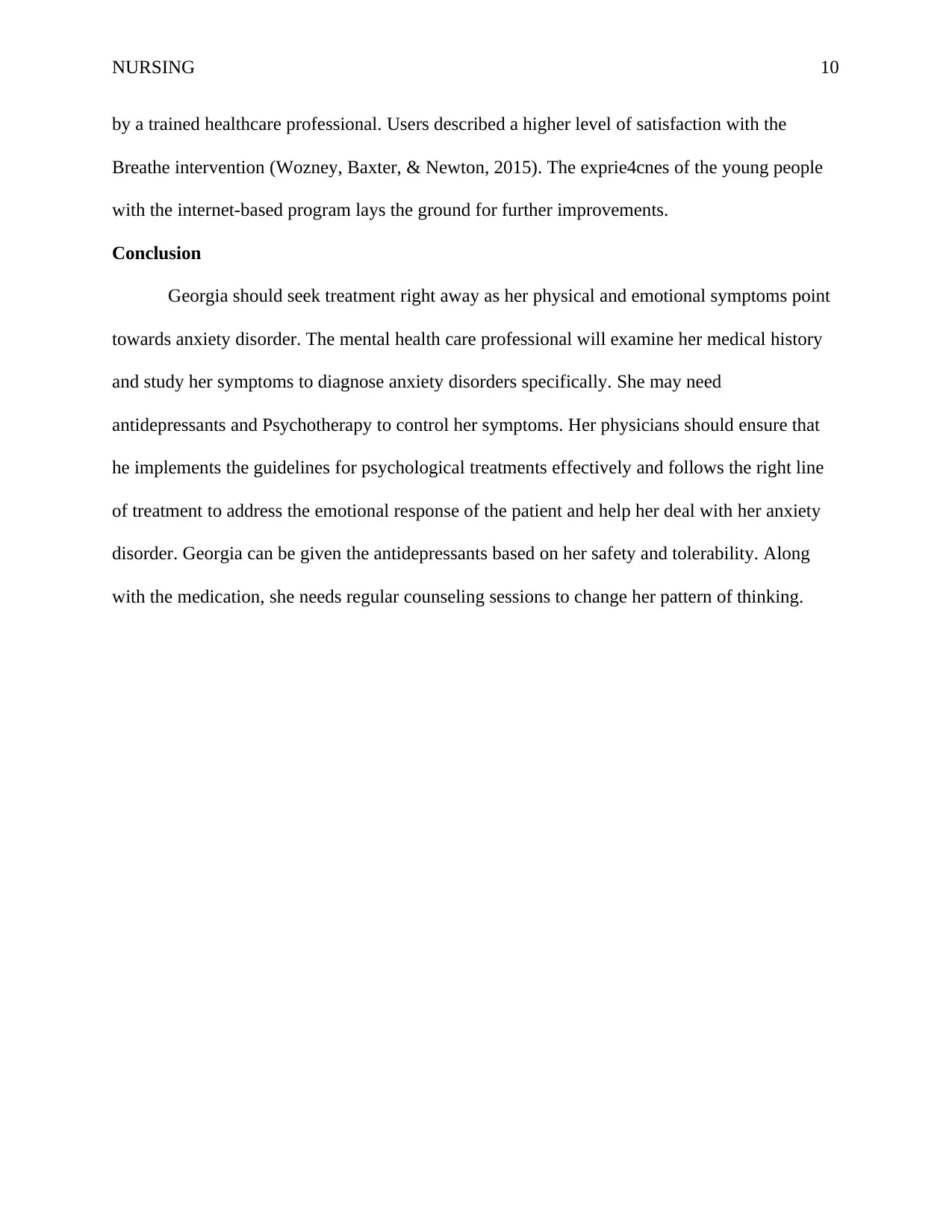
NURSING 10
by a trained healthcare professional. Users described a higher level of satisfaction with the
Breathe intervention (Wozney, Baxter, & Newton, 2015). The exprie4cnes of the young people
with the internet-based program lays the ground for further improvements.
Conclusion
Georgia should seek treatment right away as her physical and emotional symptoms point
towards anxiety disorder. The mental health care professional will examine her medical history
and study her symptoms to diagnose anxiety disorders specifically. She may need
antidepressants and Psychotherapy to control her symptoms. Her physicians should ensure that
he implements the guidelines for psychological treatments effectively and follows the right line
of treatment to address the emotional response of the patient and help her deal with her anxiety
disorder. Georgia can be given the antidepressants based on her safety and tolerability. Along
with the medication, she needs regular counseling sessions to change her pattern of thinking.
by a trained healthcare professional. Users described a higher level of satisfaction with the
Breathe intervention (Wozney, Baxter, & Newton, 2015). The exprie4cnes of the young people
with the internet-based program lays the ground for further improvements.
Conclusion
Georgia should seek treatment right away as her physical and emotional symptoms point
towards anxiety disorder. The mental health care professional will examine her medical history
and study her symptoms to diagnose anxiety disorders specifically. She may need
antidepressants and Psychotherapy to control her symptoms. Her physicians should ensure that
he implements the guidelines for psychological treatments effectively and follows the right line
of treatment to address the emotional response of the patient and help her deal with her anxiety
disorder. Georgia can be given the antidepressants based on her safety and tolerability. Along
with the medication, she needs regular counseling sessions to change her pattern of thinking.
Secure Best Marks with AI Grader
Need help grading? Try our AI Grader for instant feedback on your assignments.
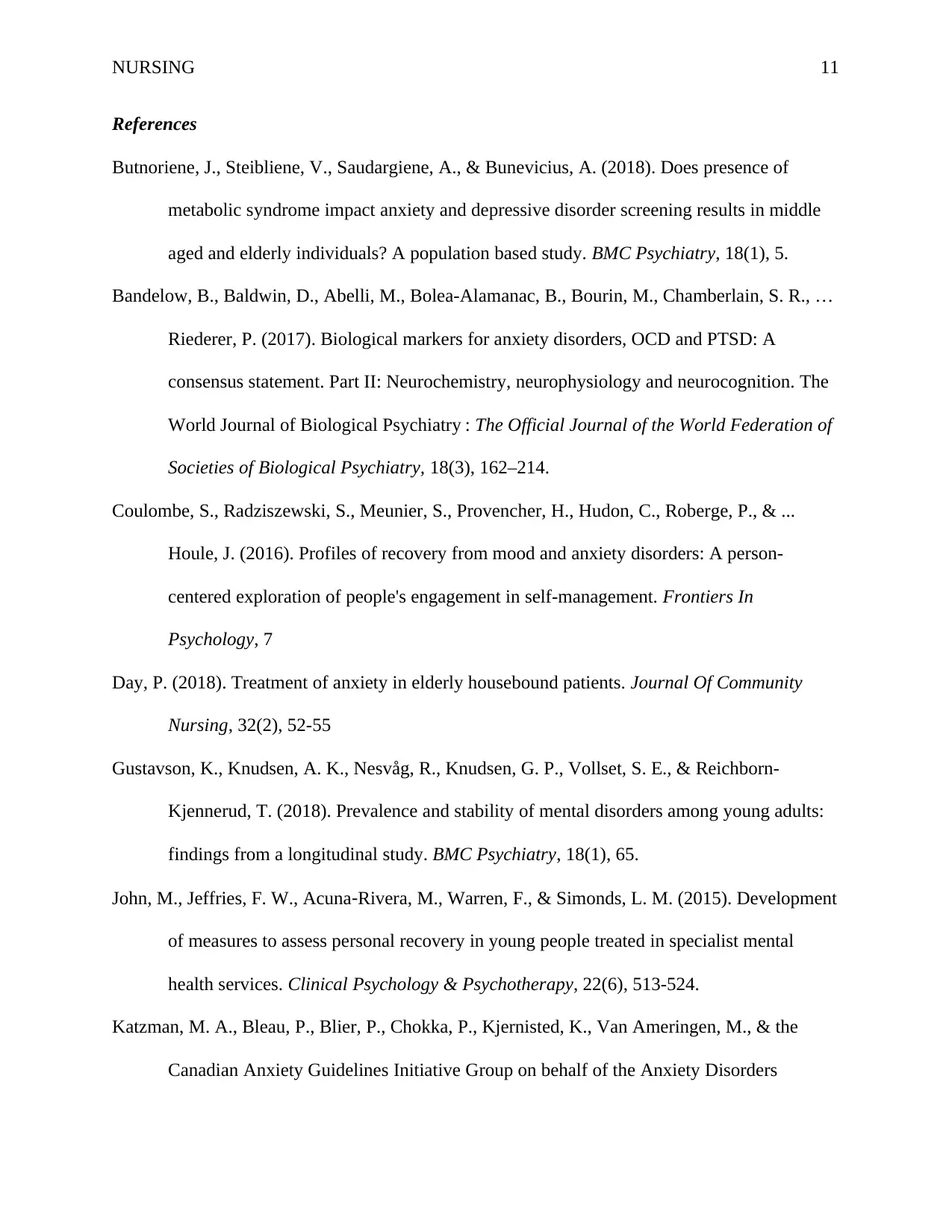
NURSING 11
References
Butnoriene, J., Steibliene, V., Saudargiene, A., & Bunevicius, A. (2018). Does presence of
metabolic syndrome impact anxiety and depressive disorder screening results in middle
aged and elderly individuals? A population based study. BMC Psychiatry, 18(1), 5.
Bandelow, B., Baldwin, D., Abelli, M., Bolea-Alamanac, B., Bourin, M., Chamberlain, S. R., …
Riederer, P. (2017). Biological markers for anxiety disorders, OCD and PTSD: A
consensus statement. Part II: Neurochemistry, neurophysiology and neurocognition. The
World Journal of Biological Psychiatry : The Official Journal of the World Federation of
Societies of Biological Psychiatry, 18(3), 162–214.
Coulombe, S., Radziszewski, S., Meunier, S., Provencher, H., Hudon, C., Roberge, P., & ...
Houle, J. (2016). Profiles of recovery from mood and anxiety disorders: A person-
centered exploration of people's engagement in self-management. Frontiers In
Psychology, 7
Day, P. (2018). Treatment of anxiety in elderly housebound patients. Journal Of Community
Nursing, 32(2), 52-55
Gustavson, K., Knudsen, A. K., Nesvåg, R., Knudsen, G. P., Vollset, S. E., & Reichborn-
Kjennerud, T. (2018). Prevalence and stability of mental disorders among young adults:
findings from a longitudinal study. BMC Psychiatry, 18(1), 65.
John, M., Jeffries, F. W., Acuna‐Rivera, M., Warren, F., & Simonds, L. M. (2015). Development
of measures to assess personal recovery in young people treated in specialist mental
health services. Clinical Psychology & Psychotherapy, 22(6), 513-524.
Katzman, M. A., Bleau, P., Blier, P., Chokka, P., Kjernisted, K., Van Ameringen, M., & the
Canadian Anxiety Guidelines Initiative Group on behalf of the Anxiety Disorders
References
Butnoriene, J., Steibliene, V., Saudargiene, A., & Bunevicius, A. (2018). Does presence of
metabolic syndrome impact anxiety and depressive disorder screening results in middle
aged and elderly individuals? A population based study. BMC Psychiatry, 18(1), 5.
Bandelow, B., Baldwin, D., Abelli, M., Bolea-Alamanac, B., Bourin, M., Chamberlain, S. R., …
Riederer, P. (2017). Biological markers for anxiety disorders, OCD and PTSD: A
consensus statement. Part II: Neurochemistry, neurophysiology and neurocognition. The
World Journal of Biological Psychiatry : The Official Journal of the World Federation of
Societies of Biological Psychiatry, 18(3), 162–214.
Coulombe, S., Radziszewski, S., Meunier, S., Provencher, H., Hudon, C., Roberge, P., & ...
Houle, J. (2016). Profiles of recovery from mood and anxiety disorders: A person-
centered exploration of people's engagement in self-management. Frontiers In
Psychology, 7
Day, P. (2018). Treatment of anxiety in elderly housebound patients. Journal Of Community
Nursing, 32(2), 52-55
Gustavson, K., Knudsen, A. K., Nesvåg, R., Knudsen, G. P., Vollset, S. E., & Reichborn-
Kjennerud, T. (2018). Prevalence and stability of mental disorders among young adults:
findings from a longitudinal study. BMC Psychiatry, 18(1), 65.
John, M., Jeffries, F. W., Acuna‐Rivera, M., Warren, F., & Simonds, L. M. (2015). Development
of measures to assess personal recovery in young people treated in specialist mental
health services. Clinical Psychology & Psychotherapy, 22(6), 513-524.
Katzman, M. A., Bleau, P., Blier, P., Chokka, P., Kjernisted, K., Van Ameringen, M., & the
Canadian Anxiety Guidelines Initiative Group on behalf of the Anxiety Disorders
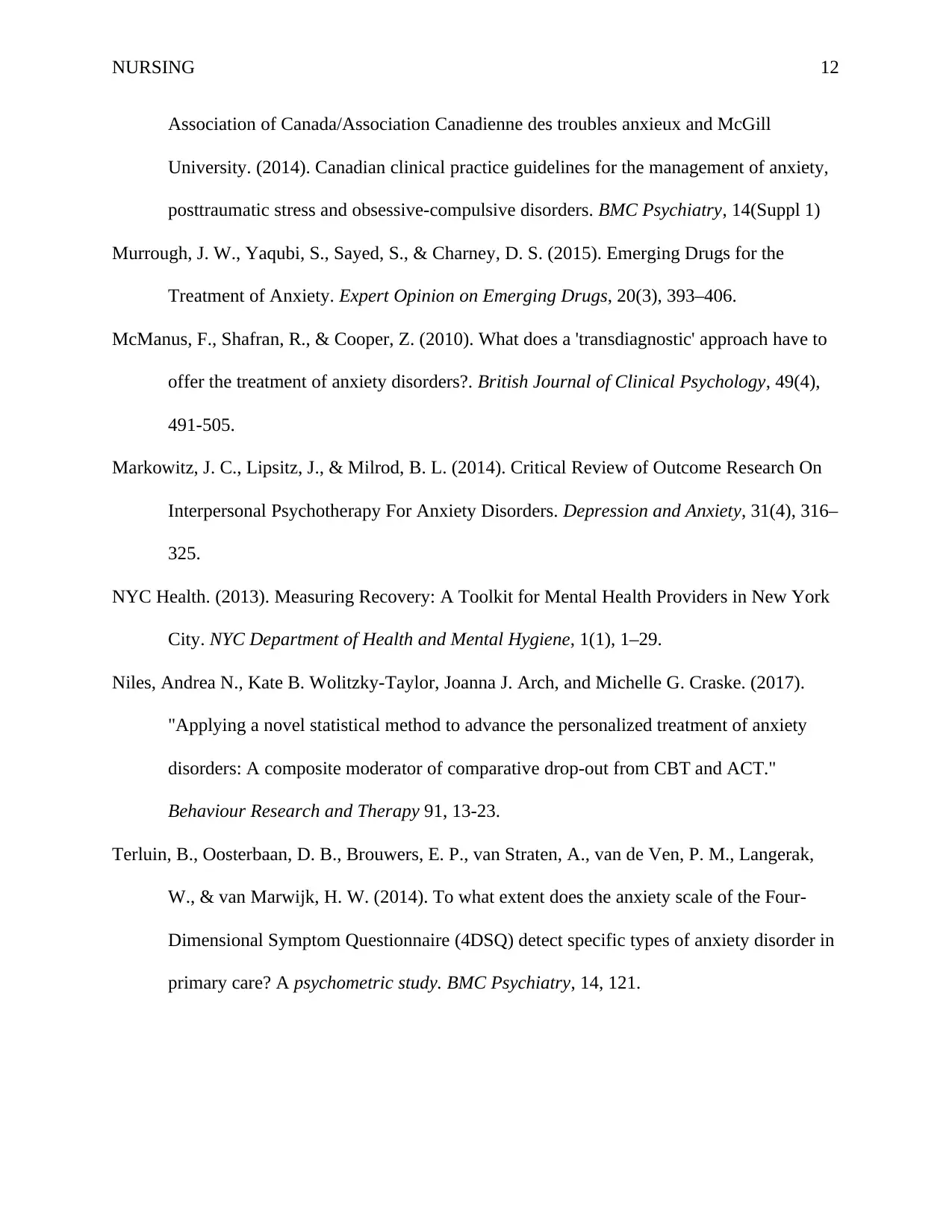
NURSING 12
Association of Canada/Association Canadienne des troubles anxieux and McGill
University. (2014). Canadian clinical practice guidelines for the management of anxiety,
posttraumatic stress and obsessive-compulsive disorders. BMC Psychiatry, 14(Suppl 1)
Murrough, J. W., Yaqubi, S., Sayed, S., & Charney, D. S. (2015). Emerging Drugs for the
Treatment of Anxiety. Expert Opinion on Emerging Drugs, 20(3), 393–406.
McManus, F., Shafran, R., & Cooper, Z. (2010). What does a 'transdiagnostic' approach have to
offer the treatment of anxiety disorders?. British Journal of Clinical Psychology, 49(4),
491-505.
Markowitz, J. C., Lipsitz, J., & Milrod, B. L. (2014). Critical Review of Outcome Research On
Interpersonal Psychotherapy For Anxiety Disorders. Depression and Anxiety, 31(4), 316–
325.
NYC Health. (2013). Measuring Recovery: A Toolkit for Mental Health Providers in New York
City. NYC Department of Health and Mental Hygiene, 1(1), 1–29.
Niles, Andrea N., Kate B. Wolitzky-Taylor, Joanna J. Arch, and Michelle G. Craske. (2017).
"Applying a novel statistical method to advance the personalized treatment of anxiety
disorders: A composite moderator of comparative drop-out from CBT and ACT."
Behaviour Research and Therapy 91, 13-23.
Terluin, B., Oosterbaan, D. B., Brouwers, E. P., van Straten, A., van de Ven, P. M., Langerak,
W., & van Marwijk, H. W. (2014). To what extent does the anxiety scale of the Four-
Dimensional Symptom Questionnaire (4DSQ) detect specific types of anxiety disorder in
primary care? A psychometric study. BMC Psychiatry, 14, 121.
Association of Canada/Association Canadienne des troubles anxieux and McGill
University. (2014). Canadian clinical practice guidelines for the management of anxiety,
posttraumatic stress and obsessive-compulsive disorders. BMC Psychiatry, 14(Suppl 1)
Murrough, J. W., Yaqubi, S., Sayed, S., & Charney, D. S. (2015). Emerging Drugs for the
Treatment of Anxiety. Expert Opinion on Emerging Drugs, 20(3), 393–406.
McManus, F., Shafran, R., & Cooper, Z. (2010). What does a 'transdiagnostic' approach have to
offer the treatment of anxiety disorders?. British Journal of Clinical Psychology, 49(4),
491-505.
Markowitz, J. C., Lipsitz, J., & Milrod, B. L. (2014). Critical Review of Outcome Research On
Interpersonal Psychotherapy For Anxiety Disorders. Depression and Anxiety, 31(4), 316–
325.
NYC Health. (2013). Measuring Recovery: A Toolkit for Mental Health Providers in New York
City. NYC Department of Health and Mental Hygiene, 1(1), 1–29.
Niles, Andrea N., Kate B. Wolitzky-Taylor, Joanna J. Arch, and Michelle G. Craske. (2017).
"Applying a novel statistical method to advance the personalized treatment of anxiety
disorders: A composite moderator of comparative drop-out from CBT and ACT."
Behaviour Research and Therapy 91, 13-23.
Terluin, B., Oosterbaan, D. B., Brouwers, E. P., van Straten, A., van de Ven, P. M., Langerak,
W., & van Marwijk, H. W. (2014). To what extent does the anxiety scale of the Four-
Dimensional Symptom Questionnaire (4DSQ) detect specific types of anxiety disorder in
primary care? A psychometric study. BMC Psychiatry, 14, 121.
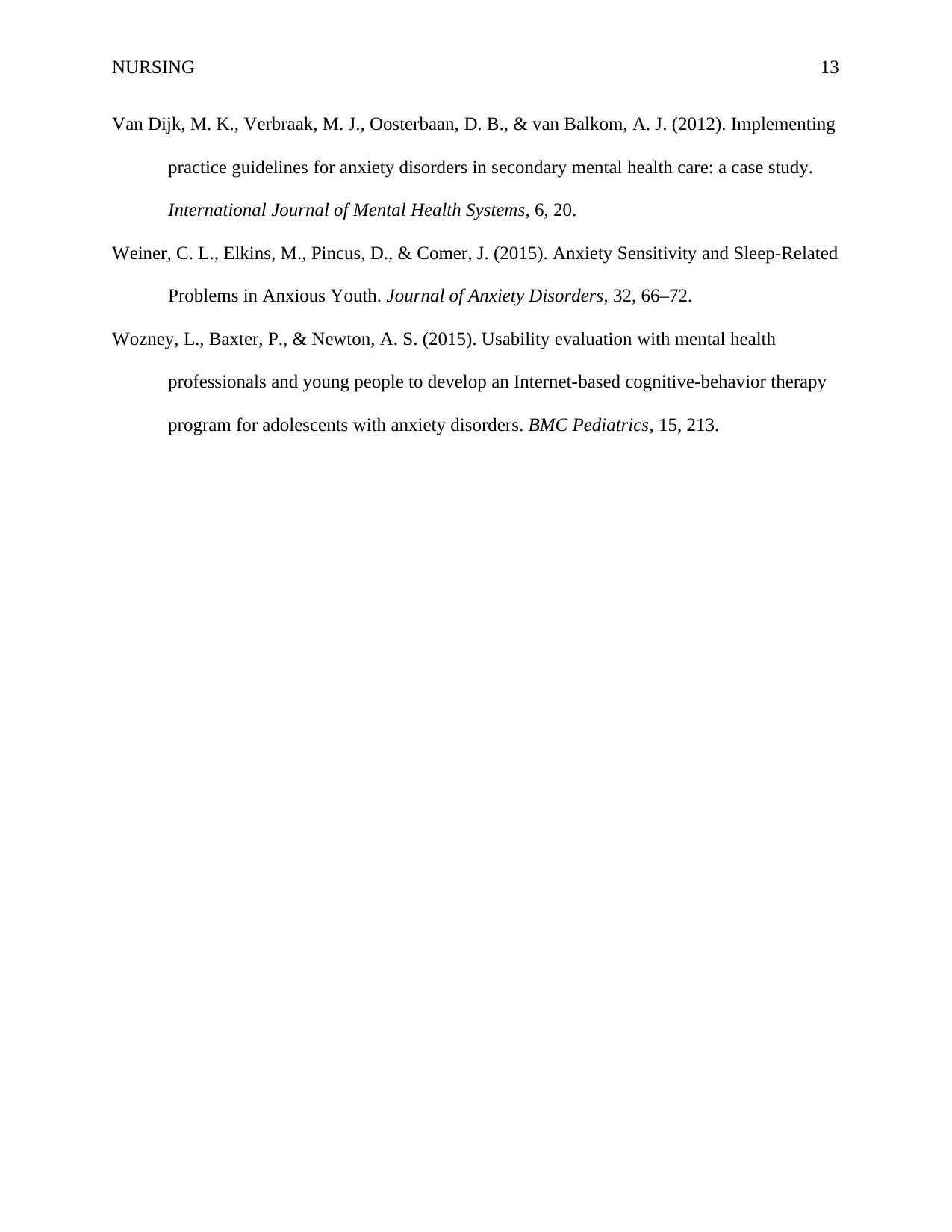
NURSING 13
Van Dijk, M. K., Verbraak, M. J., Oosterbaan, D. B., & van Balkom, A. J. (2012). Implementing
practice guidelines for anxiety disorders in secondary mental health care: a case study.
International Journal of Mental Health Systems, 6, 20.
Weiner, C. L., Elkins, M., Pincus, D., & Comer, J. (2015). Anxiety Sensitivity and Sleep-Related
Problems in Anxious Youth. Journal of Anxiety Disorders, 32, 66–72.
Wozney, L., Baxter, P., & Newton, A. S. (2015). Usability evaluation with mental health
professionals and young people to develop an Internet-based cognitive-behavior therapy
program for adolescents with anxiety disorders. BMC Pediatrics, 15, 213.
Van Dijk, M. K., Verbraak, M. J., Oosterbaan, D. B., & van Balkom, A. J. (2012). Implementing
practice guidelines for anxiety disorders in secondary mental health care: a case study.
International Journal of Mental Health Systems, 6, 20.
Weiner, C. L., Elkins, M., Pincus, D., & Comer, J. (2015). Anxiety Sensitivity and Sleep-Related
Problems in Anxious Youth. Journal of Anxiety Disorders, 32, 66–72.
Wozney, L., Baxter, P., & Newton, A. S. (2015). Usability evaluation with mental health
professionals and young people to develop an Internet-based cognitive-behavior therapy
program for adolescents with anxiety disorders. BMC Pediatrics, 15, 213.
1 out of 13
Related Documents
Your All-in-One AI-Powered Toolkit for Academic Success.
+13062052269
info@desklib.com
Available 24*7 on WhatsApp / Email
![[object Object]](/_next/static/media/star-bottom.7253800d.svg)
Unlock your academic potential
© 2024 | Zucol Services PVT LTD | All rights reserved.





